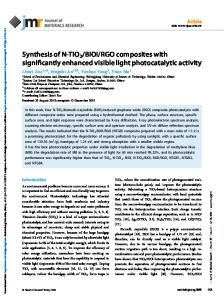In situ construction of BiOBr/Ag 3 PO 4 composites with enhanced visible light photocatalytic performances
- PDF / 597,547 Bytes
- 8 Pages / 584.957 x 782.986 pts Page_size
- 72 Downloads / 385 Views
The BiOBr/Ag3PO4 composites were fabricated by a facile in situ deposition of Ag3PO4 nanoparticles on the BiOBr microsheets and analyzed by X-ray diffraction, scanning electron microscope, high resolution transmission electron microscope, X-ray photoelectron spectroscopy, UV–vis diffuse reflectance absorption spectra, Fourier transform infrared, Raman, photoluminescence (PL), and photoelectrochemical techniques. The photocatalytic performances of as-prepared samples were investigated and compared through degradation of Rhodamine B (RhB) solution. The results suggested that 30 wt% amount of BiOBr in the composites possessed the highest photocatalytic activity. The remarkably improved photocatalytic performances of BiOBr/Ag3PO4 composites could be ascribed to the efficient separation of electron–hole pairs, due to suitable energy band potentials between BiOBr and Ag3PO4. Furthermore, the photoelectrochemical and PL tests verified the separation and transfer efficiency of charges was promoted.
I. INTRODUCTION
Solving the energy and environmental issues via semiconductor photocatalytic technology has attracted wide attention in the past decades.1,2 Enormous effects have been devoted to develop visible-light-induced photocatalysts such as BiOX (X 5 Cl, Br, I),3 Bi2MoO6,4 BiVO4,5 Bi2WO6,6 In2S3,7 ZnIn2S4,8 AgBr,9 Ag3PO4,10 Ag2CO3,11 AgVO3,12 and g-C3N4,13 considering full harvesting of solar light. Among these catalysts, Ag3 PO4 has been seemed as a very promising candidate for photocatalytic applications because of its good photodegradation organic dyes capacity. However, bare Ag3PO4 is prone to photocorrosion and decomposing to low active Ag in the process of photoreaction, which could seriously deteriorate its photocatalytic activity.14 To solve this problem and improve stability, coupling Ag3PO4 with other semiconductors to formation composites has been extensively developed, for instance, Ag3PO4/TiO2,15 Ag3PO4/ZnO,16 Ag3PO4/SnO2,17 Ag3PO4/Bi2MoO6,18 Ag3PO4/Bi2WO6,19 Ag3PO4/WO3,20 Ag3PO4/g-C3N4,21 Ag3PO4/BiVO4,22 and so on. The well-matched energy bands’ structure of these composites is beneficial for the separation and migration of electron–hole pairs and then boosting the photoactivity and photostability. The layered structure of BiOX (X 5 Cl, Br, I) gives high carrier mobility and little recombination of electron–hole pairs, which make it become an excellent photocatalyst.
However, the photocatalytic performance of BiOX should be further improved from the practical applications. Until now, a large number of BiOX-based composites such as BiOCl/g-C3 N4 ,23 BiOI/TiO 2 , 24 BiOI/Bi2WO6,25 BiOBr/ZnFe2O4,26 BiOBr/Bi2WO6,27 BiOBr/BiVO4,28 BiOBr/BiMoO6,29 and BiOBr/g-C3N430 have been reported, which exhibit the improved photocatalytic activity than that of single BiOX. Recently some research groups have combined BiOX with Ag 3PO4 to fabricate BiOX/Ag 3PO4 composites. The resultant photocatalysts (BiOCl/Ag 3PO4, 31 BiOBr/Ag3 PO4 , 32 BiOI/Ag3PO433,34) display the outstanding photoactivity and photostability. Based on the afore
Data Loading...











